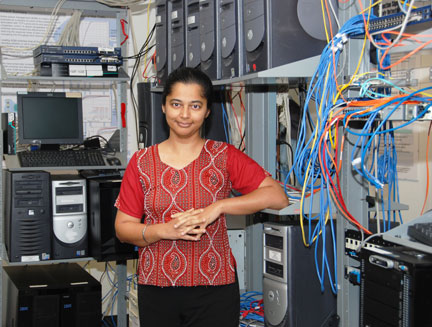Making High-Speed Networks Faster

For more than two decades, Internet applications have been relying on the standard transport protocol TCP (Transmission Control Protocol) to make best usage of available network resources. However, even the state-of-the-art TCP variants now fail to scale to high enough network speeds to meet the requirements of the computational science communities. To address this problem, Associate Professor Jasleen Kaur and her research team have decided to do away with the traditional TCP framework of operation and create a novel paradigm that can be scaled to even Terabit-and-higher speeds.
The standard TCP framework tries to figure out how fast it can send data by sending some packets at a particular rate and seeing if those packets make their way through the network or not. This probing is done for a time duration of about the round-trip time (RTT) of the network path (RTT-scale probing). Depending on whether the packets make their way through or not, TCP scales up or down the rate at which subsequent packets are sent. Due to the large RTT-scale used for probing, even the best of current protocols have trouble achieving several Gigabits-per-second (Gbps) speeds without the risk of serious congestion collapse on the network.
Kaur’s approach sheds the legacy RTT-scale framework and instead designs the packet-scale congestion control paradigm. This new paradigm enables the protocol to operate at fine timescales and at a frequency close to the frequency of packet transmissions. The paradigm relies on two main ideas. The first is fine-scale probing, which generates finely-controlled inter-packet spacing at the sender and observes changes in these at the receiver to estimate the current available bandwidth in the network. The second is probing-without-overloading, which exploits the fine-scale of probing to probe for a wide range of sending rates within an RTT, without causing persistent queuing at bottleneck links. The paradigm also helps truly achieve RTT fairness and friendliness to conventional TCP traffic — two goals that have so far remained elusive to high-speed transport protocols.
To test this new paradigm, Kaur is partnering with the Renaissance Computing Institute (RENCI) to use their Breakable Experimental Network (BEN), a regional optical network test bed for experiments with disruptive networking technologies. BEN can also be connected to the National Lambda Rail (NLR), the high-speed research network that connects universities across the U.S. This allows the researchers to use the machines in the computer science department as servers and clients and emulate very long distance network paths by setting up a path beginning in the networking lab at UNC, going through BEN to the NLR through several cities across the U.S. and returning to BEN and to the lab in the CS department.
Kaur has recently received two National Science Foundation grants to support the research on the paradigm. The focus of the first grant is on investigating research challenges including the sensitivity of the paradigm to “noise” in the end-to-end delays experienced by packets, the implementation of fine-scaled inter-packet spacing in current end-systems, and the stability, sensitivity and fairness of the paradigm under highly-aggregated and stressful traffic conditions. The second grant is for developing a production-quality ultra-high speed implementation of the paradigm on the Linux operating system, and deploying it on the infrastructure of three scientific research projects. Prof. Don Smith is a co-PI on this project. The targeted infrastructures are those of the UNC Institute for the Environment, Carolina Center for Genome Sciences, and the Los Alamos National Lab.
More information about this research is available at: http://rapid.web.unc.edu
